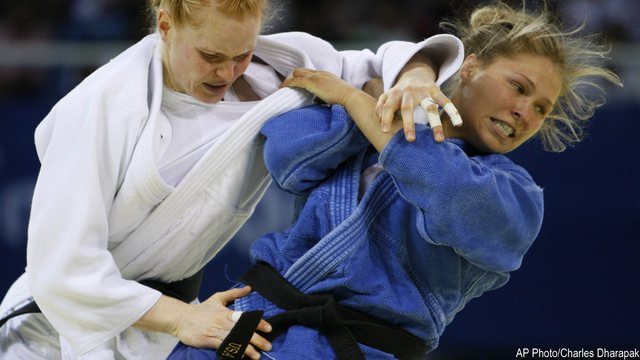Learn the Top 5 Amazing Judo Techniques

VIDEO: Watch as the Judo master herself, Ronda Rousey use her Judo techniques to dominate!
We often see drawings or pictures of judokas with bent arms in order to defend themselves of attack, at a first glance one might think about jujutsu rather than judo. Going through some of the papers it is interesting to find out, that Kano Shihan was working on a study of techniques without the traditional grip.
As a matter of fact Kodokan Judo does not only foresee throws and ground techniques, but also strikes, the so called atemi waza, which include kicks, punches and hits. Of course all these actions are prohibited in “Olympic Judo” as modern sport’s expression, where normally the two opponents go for the grips in order to throw the other.
Judo is a modern Japanese martial art and Olympic sport. The Japanese word Judo means “gentle way.” The object of Judo is to throw one’s opponent to the ground, immobilize, or subdue one’s opponent with a grappling maneuver. Or one can force a contestant to submit by applying pressure in the form of a joint lock to the elbow or by executing a choke.
Strikes and thrusts as well as weapons defenses are part of judo, but only in pre-arranged forms which are called Katas. Katas not permitted in judo competition or free practice. This martial art originated in Japan in the late nineteenth century. Eventually, the philosophy and successive pedagogy developed for judo became the model for just about all modern Eastern martial arts that developed from “traditional” colleges.
Shime-waza (strangles) are an important part of judo. The strangles explained in this article are: nami-juji-jime (normal cross strangle), kata-juji-jime (half cross strangle), kata-juji-jime (half cross strangle): a modification and okuri-eri-jime (sliding collar strangle). These strangles are a most important part of judo practice.
List of Judo katas below
Goshin-Jutsu Kata – Judo’s self-defense kata
Itsutsu-No Kata
Ju-No Kata
Katame-No Kata
Kime-No Kata
Koshiki-No Kata
Nage-No Kata
1.Nami-juji-jime (normal cross strangle)
As your opponent lies on his back, you straddle his abdomen in front and place both your knees on the mat. Grasp his left collar with your left hand and his right collar with your right hand in the regular hold as deeply as possible. Strike your upper body towards his face, simultaneously pulling both your elbows outwards to create the proper pressure for the strangle.
2.Kata-juji-jime (half cross strangle)
If it is difficult for you to grasp both of your opponent’s lapels, then you may apply kata-juji-jime on him. Straddle him with one or both of your knees on the mat. Then grasp his left lapel as far back as possible with your right hand in the regular palm-down hold and with your left hand in the palm-up hold. Carry your right arm up and around his head toward your left and press the right side of his neck.
3.Kata-juji-jime (half cross strangle): a modification
Let us study a modification of kata-juji-jime in which we attack the opponent from the side. He is lying on his side on the mat, and you are standing by him on his left side. Lower your waist and place your left knee on the mat. You then grasp his left lapel as far around to the back as possible with your left hand, palm upward. With your right hand
you grasp his right collar in the regular (palm down) hold. You then push him down with your right elbow while pulling your left hand to the left.
4.Okuri-eri-jime (sliding collar strangle)
In both nami-juji-jime and kata-juji-jime you attack your opponent from the front. There are, however, some techniques in which you attack him from behind. Whenever he turns his back to you, you have a good opportunity to attack him. Okuri-eri-jime is one of the techniques of attack from the rear.





